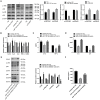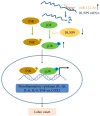miR-132-3p Modulates DUSP9-Dependent p38/JNK Signaling Pathways to Enhance Inflammation in the Amnion Leading to Labor
- PMID: 35163786
- PMCID: PMC8836965
- DOI: 10.3390/ijms23031864
miR-132-3p Modulates DUSP9-Dependent p38/JNK Signaling Pathways to Enhance Inflammation in the Amnion Leading to Labor
Abstract
Labor is a process of inflammation and hormonal changes involving both fetal and maternal compartments. MicroRNA-132-3p (miR-132-3p) has been reported to be involved in the development of inflammation-related diseases. However, little is known about its potential role in labor onset. This study aimed to explore the mechanism of miR-132-3p in amnion for labor initiation. In the mouse amnion membranes, the expression of miR-132-3p was found to increase gradually during late gestation. In human amniotic epithelial cell line (WISH), upregulation of miR-132-3p was found to increase proinflammatory cytokines and cyclooxygenase 2 (COX2) as well as prostaglandin E2 (PGE2), which was suppressed by miR-132-3p inhibitor. Dual-specificity phosphatase 9 (DUSP9) was identified as a novel target gene of miR-132-3p, which could be negatively regulated by miR-132-3p. DUSP9 was present in the mouse amnion epithelial cells, with a decrease in its abundance at 18.5 days post coitum (dpc) relative to 15.5 dpc. Silencing DUSP9 was found to facilitate the expression of proinflammatory cytokines and COX2 as well as PGE2 secretion in WISH cells, which could be attenuated by p38 inhibitor SB203580 or JNK inhibitor SP600125. Additionally, intraperitoneal injection of pregnant mice with miR-132-3p agomir not only caused preterm birth, but also promoted the abundance of COX2 as well as phosphorylated JNK and p38 levels, and decreased DUSP9 level in mouse amnion membranes. Collectively, miR-132-3p might participate in inflammation and PGE2 release via targeting DUSP9-dependent p38 and JNK signaling pathways to cause preterm birth.
Keywords: DUSP9; amnion; inflammation; labor; miR-132-3p; p38/JNK.
Conflict of interest statement
The authors declare no conflict of interest.
Figures








Similar articles
-
miR-144 and targets, c-fos and cyclooxygenase-2 (COX2), modulate synthesis of PGE2 in the amnion during pregnancy and labor.Sci Rep. 2016 Jun 14;6:27914. doi: 10.1038/srep27914. Sci Rep. 2016. PMID: 27297132 Free PMC article.
-
Hsa-miR-3928-3p targets the CCL3/CCR5 axis to induce amniotic epithelial cell senescence involved in labor initiation.Placenta. 2024 Oct;156:98-107. doi: 10.1016/j.placenta.2024.09.008. Epub 2024 Sep 10. Placenta. 2024. PMID: 39299215
-
Epigenetic silencing of DUSP9 induces the proliferation of human gastric cancer by activating JNK signaling.Oncol Rep. 2015 Jul;34(1):121-8. doi: 10.3892/or.2015.3998. Epub 2015 May 20. Oncol Rep. 2015. PMID: 25998184
-
Anti-inflammatory effects of dexmedetomidine on human amnion-derived WISH cells.Int J Med Sci. 2020 Sep 9;17(16):2496-2504. doi: 10.7150/ijms.49909. eCollection 2020. Int J Med Sci. 2020. PMID: 33029092 Free PMC article.
-
DUSP9, a Dual-Specificity Phosphatase with a Key Role in Cell Biology and Human Diseases.Int J Mol Sci. 2021 Oct 26;22(21):11538. doi: 10.3390/ijms222111538. Int J Mol Sci. 2021. PMID: 34768967 Free PMC article. Review.
Cited by
-
miR-548az-5p induces amniotic epithelial cell senescence by regulating KATNAL1 expression in labor.Sci Rep. 2024 Dec 5;14(1):30380. doi: 10.1038/s41598-024-82390-y. Sci Rep. 2024. PMID: 39638877 Free PMC article.
-
Pyroptosis: A Promising Mechanism Linking SARS-CoV-2 Infection to Adverse Pregnancy Outcomes.Int J Mol Sci. 2023 May 25;24(11):9278. doi: 10.3390/ijms24119278. Int J Mol Sci. 2023. PMID: 37298229 Free PMC article.
-
Cells of the Maternal-Fetal Interface May Contribute to Epidural-Related Maternal Fever After Administration of Ropivacaine: The Role of Phosphatases DUSP9 and PHLPP1.Int J Mol Sci. 2025 Jun 9;26(12):5520. doi: 10.3390/ijms26125520. Int J Mol Sci. 2025. PMID: 40564984 Free PMC article.
References
MeSH terms
Substances
LinkOut - more resources
Full Text Sources
Medical
Molecular Biology Databases
Research Materials

